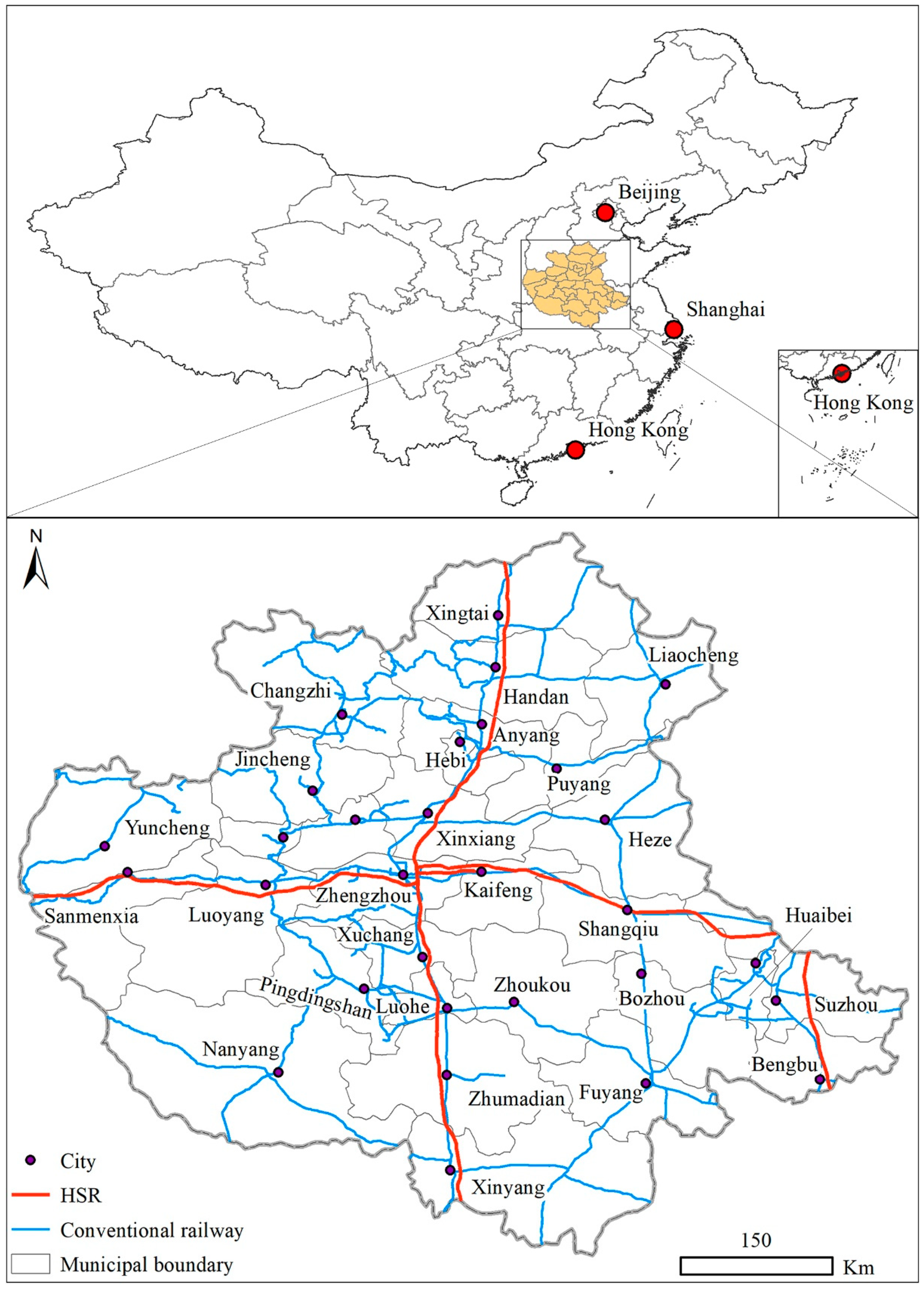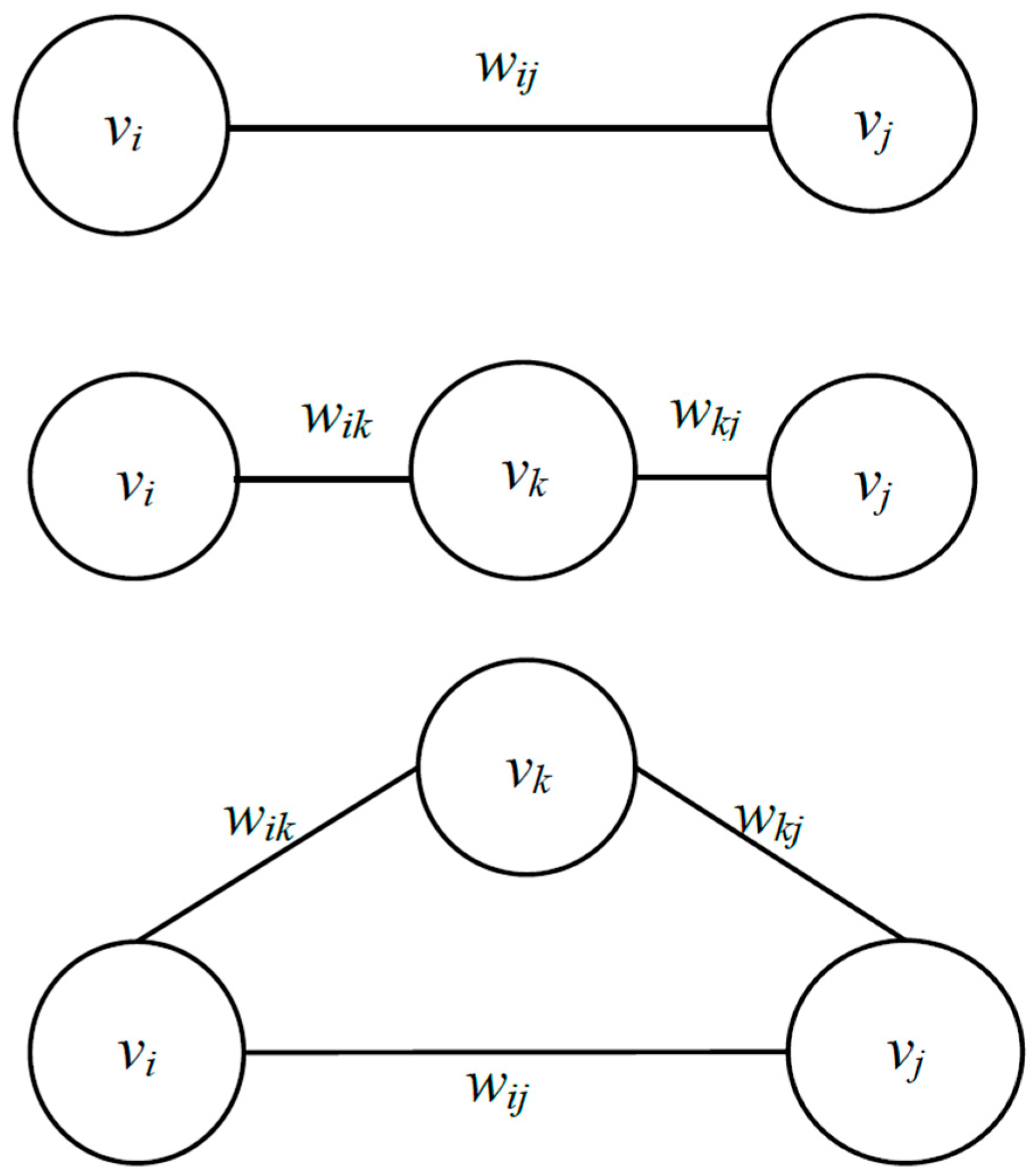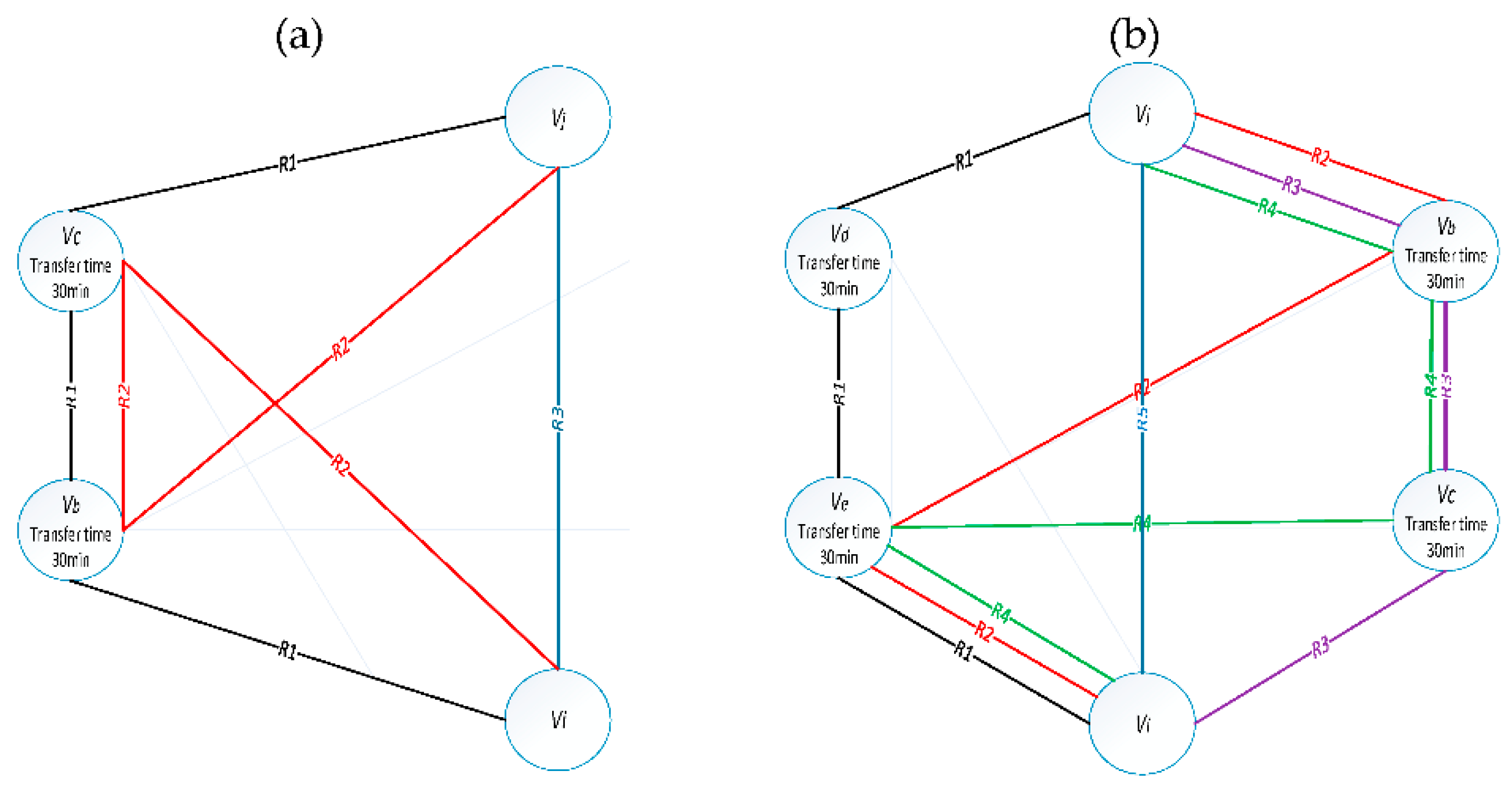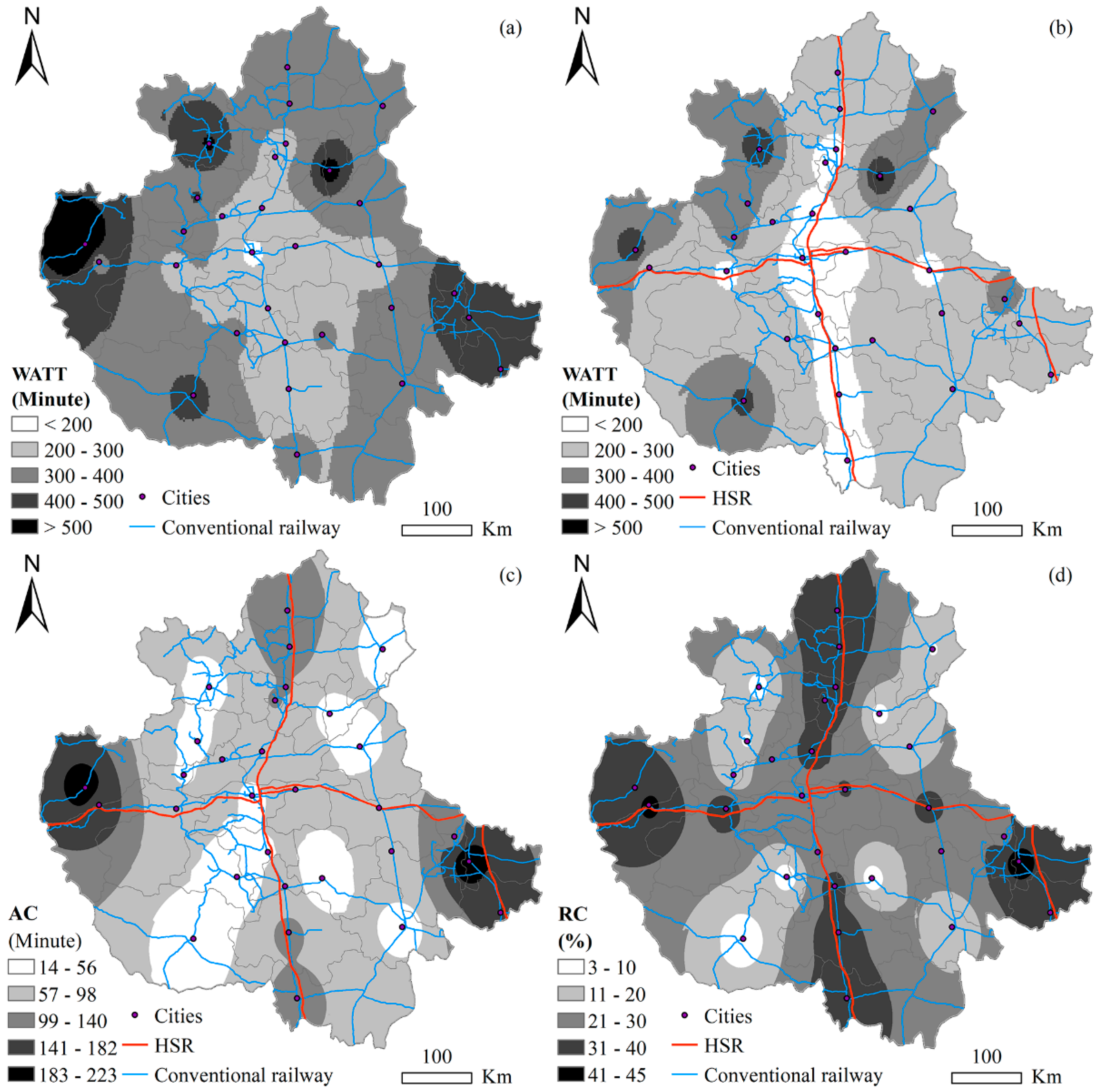Efficiency and Spatial Equity Impacts of High-Speed Rail on the Central Plains Economic Region of China
Abstract
1. Introduction
2. Review of the Impacts of HSR
2.1. Efficiency of HSR
2.2. Spatial Equity of HSR
3. Setting, Data, and Methodology
3.1. Study Area
3.2. Data
3.3. Methodology
3.3.1. Weighted Average Travel Time
3.3.2. Coefficients of Variation
3.3.3. Constructed “Efficiency-Equity” Model
- (1)
- Origins and destinations are excluded from upgraded lines, i,j ≠ b,c,d,e.From vi to vj: R1 = eid + wde·ede + eej + 2t, R2 = eie + wde·eed + edj + 2t, and R3 = eic + wbc·ecb + ebj + 2t… 13 routes are available.The shortest-travel-time route is R(vi,vj) = Min{R1, R2, …, R13}. Since there are too many routes, only five of them are shown in the Figure 3b.
- (2)
- One node of origins and destinations is located on one upgraded line. For instance, i ≠ b,c,d,e and j = e.From Ai to Aj: R1 = eid + wdj·edj + t, R2 = eib + wbc·ebc + ecd + wdj·edj + 3t, and R3 = eib + wbc·ebc + ecj + 2t… and six routes are available. R(vi,vj) = Min{R1, R2…, R6}.
- (3)
- Origins and destinations are positioned on two separate upgraded lines. For example, i = b, j = d.From Ai to Aj: R1= eij, R2= wic·eic +ecj +t, R3= wic·eic+ece+eej +2t, and R4= eie +wej·eej+t. R(vi,vj)=Min{R1, R2, R3, R4}.
- (4)
- Origins and destinations are positioned on the same upgraded lines. For example, i = d,j = e.From vi to vj: R1 = wij·eij, R2 = eib + wbc·ebc + ecj + 2t, and R3 = eic + wbc·ecb + ebj + 2t. R(vi,vj) = Min{R1, R2, R3}.
- (1)
- Origins and destinations are excluded from upgraded lines. i ≠ j≠ b≠ c≠ d.From vi to vj: R1 = vij, R2 = vib + wbc·ebc + ecd + edj + 3t, and R3 = eid + wde·edc + wbc·ecb + ebj + 3t… seven routes are available. R(vi,vj) = Min{R1, R2…, R7}
- (2)
- One node from origins and destinations is located on one upgraded line, not at the junction of the two upgraded lines; the other node is not on the two upgraded lines. For example, i ≠ b,c,d and j = d.From vi to vj: R1 = eid, R2 = eic +wcj·ecj+t, and R3= eib + wbc· ebc + wcj·ecj + 2t, R(vi,vj) = Min{R1, R2, R3}.
- (3)
- One node from origins or destinations is located at the junction between two upgraded lines. For example, i ≠ b,c,d and j = c.From vi to vj: R1 = eij, R2 = eib + wbj·ebj + t, R3 = eid + wdj·edj + t, and R(vi,vj) = Min{R1, R2, R3}.
- (4)
- Origins and destinations are located along two upgraded lines and both of them are not at the junction. For example, i = b, j = d.From Ai to Aj: R1 = eij, R2 = wic·eic + wcj·ecj + t, and R(vi,vj) = Min{R1, R2}.
- (5)
- Origins and destinations are located on two upgraded lines, and one is located at the junction. For example, i = b, j = c.R1 = wij·eij, R2 = eid + wdj·edj + t, and R(vi,vj) = Min{R1, R2}.
4. Results and Analysis
4.1. Efficiency Analysis
4.2. Equity Analysis
5. Discussion and Conclusions
5.1. Searching for Upgraded CR Lines
5.2. Comparisons of Relevant Research
5.3. Future Research Directions
5.4. Conclusions
Author Contributions
Funding
Conflicts of Interest
Appendix A
| Representative Author, Year | Contributions in Approach and Results |
|---|---|
| Gutiérrez, J. 1996, 2001, 2010 | Use Weighted average travel time; Economic potential and Daily accessibility indicators; HSR can improve city accessibility levels and changing regional spatial structure. |
| López, S. 2008 | Comprehensive use accessibility and spatial equity indicators: Location; Potential; Network efficiency; Daily accessibility; CV; GINI coefficient; Theil indices; Atkinson. |
| Garmendia, M. 2011 | Assess the impact of high-speed infrastructures from the perspective of commuting and discretionary flows; HSR can improve the accessibility and location advantages of sparsely populated or isolated areas and enhance regional equity. |
| Ortega, E. 2012 | Evaluate cohesion impacts from different planning levels: regional, corridor and national levels; The national and corridor levels appear positive cohesion effects, but region appear polarization effects; some policy measures are suggested. |
| Levinson, D. 2012 | Small and medium-sized cities may achieve absolute accessibility and lose in relative position. |
| Monzón, A. 2013 | Assess the magnitude and distribution of the accessibility. |
| Kim, M. 2015 | Assess the accessibility of each stage of HSR network; Accessibility improvement has concentrated in the primary HSR corridor cities. |
| Wang, L. 2018 | Added territorial and population accessibility to measure spatial equity; HSR has not decreased the disparity in territorial accessibility but decrease the disparity in population accessibility. |
| Yang, J. 2018 | Added social demand index to measure spatial equity; Form “corridors” and “islands”. |
| Monzón, A. 2019 | Assess “accessibility-based” territorial cohesion effects of HSR corridors in 1990–2015 period; At the beginning of the construction of the HSR network, efficiency was prioritized; Need to integrate efficiency and Spatial equity. |
References
- Maækiewicz, A.; Ratajczak, W. Towards a new definition of topological accessibility. Transp. Res. B Methodol. 1996, 30, 47–79. [Google Scholar] [CrossRef]
- Kim, M.; Sultana, S. The impacts of high-speed rail extensions on accessibility and spatial equity changes in South Korea from 2004 to 2018. J. Transp. Geogr. 2015, 45, 48–61. [Google Scholar] [CrossRef]
- Hansen, W.G. How accessibility shapes land use. J. Am. Inst. Plan. 1959, 25, 73–76. [Google Scholar] [CrossRef]
- Adler, N.; Pels, E.; Nash, C. High-speed rail and air transport competition: Game engineering as tool for cost-benefit analysis. Transp. Res. B Methodol. 2010, 44, 812–833. [Google Scholar] [CrossRef]
- Monzón, A.; Ortega, E.; López, E. Efficiency and spatial equity impacts of high speed rail extensions in urban areas. Cities 2013, 30, 18–30. [Google Scholar] [CrossRef]
- Miao, Y.; Wei, F. Accessibility impact of future high speed rail corridor on the piedmont Atlantic megaregion. J. Transp. Geogr. 2018, 73, 1–12. [Google Scholar]
- Liu, L.W.; Zhang, M. High-speed rail impacts on travel times, accessibility, and economic productivity: A benchmarking analysis in city-cluster regions of China. J. Transp. Geogr. 2018, 73, 25–40. [Google Scholar] [CrossRef]
- Hou, Q.; Li, S.M. Transport infrastructure development and changing spatial accessibility in the Greater Pearl River Delta, China, 1990–2020. J. Transp. Geogr. 2011, 19, 1350–1360. [Google Scholar] [CrossRef]
- Chen, H.S.; Sun, D.Q.; Zhu, Z.J.; Zeng, J. The Impact of High-Speed Rail on Residents’ Travel Behavior and Household Mobility: A Case Study ofthe Beijing-Shanghai Line, China. Sustainability 2016, 8, 1187. [Google Scholar] [CrossRef]
- Wang, L. High-speed rail services development and regional accessibility restructuring in megaregions: A case of the Yangtze River Delta, China. Transp. Policy 2018, 72, 34–44. [Google Scholar] [CrossRef]
- Bröcker, J.; Korzhenevych, A.; Schürmann, C. Assessing spatial equity and efficiency impacts of transport infrastructure projects. Transp. Res. B Methodol. 2010, 44, 795–811. [Google Scholar] [CrossRef]
- Gutiérrez, J.; Condeço-Melhorado, A.; Martín, J.C. Using accessibility indicators and GIS to access spatial spillovers of transport infrastructure investment. J. Transp. Geogr. 2010, 18, 141–152. [Google Scholar] [CrossRef]
- Shaw, S.L.; Fang, Z.; Lu, S.; Tao, R. Impacts of high speed rail on railroad network accessibility in China. J. Transp. Geogr. 2014, 40, 112–122. [Google Scholar] [CrossRef]
- Wang, L.H.; Liu, Y.X.; Sun, C.; Liu, Y.H. Accessibility impact of the present and future high-speed rail network: A case study of Jiangsu Province, China. J. Transp. Geogr. 2016, 54, 161–172. [Google Scholar] [CrossRef]
- Hay, A. Equity and welfare in the geography of public transport provision. J. Transp. Geogr. 1993, 1, 95–101. [Google Scholar] [CrossRef]
- Yang, J.; Guo, A.D.; Li, X.M.; Huang, T. Study of the Impact of a High-Speed Railway Opening on China’s Accessibility Pattern and Spatial Equality. Sustainability 2018, 10, 2943. [Google Scholar] [CrossRef]
- Levinson, D. Accessibility impacts of high-speed rail. J. Transp. Geogr. 2012, 22, 288–291. [Google Scholar] [CrossRef]
- Cao, J.; Liu, X.Y.; Wang, Y.H.; Li, Q.Q. Accessibility impacts of China’s high-speed rail network. J. Transp. Geogr. 2013, 28, 12–21. [Google Scholar] [CrossRef]
- Ortega, E.; López, E.; Monzón, A. Territorial cohesion impacts of high-speed rail at different planning levels. J. Transp. Geogr. 2012, 24, 130–141. [Google Scholar] [CrossRef]
- Martínez Sánchez-Mateos, H.S.; Givoni, M. The accessibility impacts of a new High-Speed Rail line in the UK—A preliminary analysis of winners and losers. J. Transp. Geogr. 2012, 25, 105–114. [Google Scholar] [CrossRef]
- Wang, L.; Duan, J.D. High-speed rail network development and winner and loser cities in megaregions: The case study of Yangtze River Delta, China. Cities 2018, 83, 71–82. [Google Scholar] [CrossRef]
- Gutiérrez, J.; Gonzalez, R.; Gomez, G. The European high-speed train network: Predicted effects on accessibility patterns. J. Transp. Geogr. 1996, 4, 227–238. [Google Scholar] [CrossRef]
- Martin, J. Justifying a high-speed rail project: Social value vs. regional growth. Ann. Reg. Sci. 1997, 31, 155–174. [Google Scholar] [CrossRef]
- Javier, G. Location, economic potential and daily accessibility: An analysis of the accessibility impact of the high-speed line Madrid-Barcelona-French border. J. Transp. Geogr. 2001, 9, 229–242. [Google Scholar]
- Long, F.J.; Zheng, L.F.; Song, Z.D. High-speed rail and urban expansion: An empirical study using a time series of nighttime light satellite data in China. J. Transp. Geogr. 2018, 72, 106–118. [Google Scholar] [CrossRef]
- Páez, A.; Scott, D.M.; Morency, C. Measuring accessibility: Positive and normative implementations of various accessibility indicators. J. Transp. Geogr. 2012, 25, 141–153. [Google Scholar] [CrossRef]
- Ureña, J.M.; Menerault, P.; Garmendia, M. The high-speed rail challenge for big intermediate cities: A national, regional and local perspective. Cities 2009, 26, 266–279. [Google Scholar] [CrossRef]
- Martens, K.; Golub, A.; Robinson, G. A justice-theoretic approach to the distribution of transportation benefits: Implications for transportation planning practice in the United States. Transp. Res. A Policy Pract. 2012, 46, 684–695. [Google Scholar] [CrossRef]
- Litman, T. Evaluating transportation equity. World Transp. Policy Pract. 2002, 8, 50–65. [Google Scholar]
- Caggiani, L.; Camporeale, R.; Michele, O. Facing equity in transportation Network Design Problem: A flexible constraints based model. Transp. Policy 2017, 55, 9–17. [Google Scholar] [CrossRef]
- Chang, H.S.; Liao, C.H. Exploring an integrated method for measuring the relative spatial equity in public facilities in the context of urban parks. Cities 2011, 28, 361–371. [Google Scholar] [CrossRef]
- Thomopoulos, N.; Grant-Muller, S.; Tight, M.R. Incorporating equity considerations in transport infrastructure evaluation: Current practice and a proposed methodology. Eval. Progr. Plan. 2009, 32, 351–359. [Google Scholar] [CrossRef] [PubMed]
- El-Geneidy, A.; Levinson, D.; Diab, E.; Boisjoly, G.; Verbich, D.; Loong, C. The cost of equity: Assessing transit accessibility and social disparity using total travel cost. Transp. Res. A Policy Pract. 2016, 91, 302–316. [Google Scholar] [CrossRef]
- López, S.; Gutiérrez, J.; Gómez, G. Measuring regional cohesion effects of large-scale transport infrastructure investments: An accessibility approach. Eur. Plan. Stud. 2008, 16, 277–301. [Google Scholar] [CrossRef]
- Domanski, R. Accessibility, efficiency and spatial organization. Environ. Plan. 1979, 11, 1189–1206. [Google Scholar] [CrossRef]
- Verma, A.; Sudhira, H.S.; Rathi, S.; King, R.; Dash, N. Sustainable urbanization using high speed rail (HSR) in Karnataka, India. Res. Transp. Econ. 2013, 38, 67–77. [Google Scholar] [CrossRef]
- Hall, P. Magic carpets and seamless webs: Opportunities and constraints for high-speed trains in Europe. Built Environ. 2009, 35, 59–69. [Google Scholar] [CrossRef]
- Garmendia, M.; Ureña, J.M.; Coronado, J.M. Long-distance trips in a sparsely populated region: The impact of high-speed infrastructures. J. Transp. Geogr. 2011, 19, 537–551. [Google Scholar] [CrossRef]
- Chen, Z.H. Impacts of high-speed rail on domestic air transportation in China. J. Transp. Geogr. 2017, 62, 184–196. [Google Scholar] [CrossRef]
- Albalate, D.; Bel, G.; Fageda, X. Competition and cooperation between high-speed rail and air transportation services in Europe. J. Transp. Geogr. 2015, 42, 166–174. [Google Scholar] [CrossRef]
- Vickerman, R. High-speed rail and regional development: The case of intermediate stations. J. Transp. Geogr. 2015, 42, 157–165. [Google Scholar] [CrossRef]
- Mohino, I.; Loukaitou-Sideris, A.; Urena, J.M. Impacts of high-speed rail on metropolitan integration: An examination of London, Madrid and Paris. Int. Plan. Stud. 2014, 19, 306–334. [Google Scholar] [CrossRef]
- Monzón, A.; López, E.; Ortega, E. Has HSR improved territorial cohesion in Spain? An accessibility analysis of the first 25 years: 1990–2015. Eur. Plan. Stud. 2019, 27, 513–532. [Google Scholar] [CrossRef]
- Wu, J.; Nash, C.; Wang, D. Is high speed rail an appropriate solution to China’s rail capacity problems? J. Transp. Geogr. 2014, 40, 100–111. [Google Scholar] [CrossRef]
- Fan, J.; Li, P.X. The scientific foundation of Major Function Oriented Zoning in China. Geogr. Sci. 2009, 5, 515–531. [Google Scholar] [CrossRef]
- Wu, W.; Liang, Y.; Wu, D. Evaluating the Impact of China’s Rail Network Expansions on Local Accessibility: A Market Potential Approach. Sustainability 2006, 8, 512–613. [Google Scholar] [CrossRef]
- Jiao, J.; Wang, J.; Jin, F.; Dunford, M. Impacts on accessibility of China’s present and future HSR network. J. Transp. Geogr. 2014, 40, 123–132. [Google Scholar] [CrossRef]
- Wang, L.H.; Liu, Y.X.; Mao, L.; Sun, C. Potential Impacts of China 2030 High-Speed Rail Network on Ground Transportation Accessibility. Sustainability 2018, 10, 1270. [Google Scholar] [CrossRef]
- Wan, Y. The Matthew Effect in social commerce. Electron. Mark. 2015, 25, 313–324. [Google Scholar] [CrossRef]
- Blum, U.; Haynes, K.E.; Karlsson, C. Introduction to the special issue: The regional and urban effects of high-speed trains. Ann. Reg. Sci. 1997, 31, 1–20. [Google Scholar] [CrossRef]
- Biggiero, L.; Pagliara, F.; Patrone, A.; Peruggini, F. Spatial equity and high-speed rail systems. Int. J. Transp. Dev. Integr. 2017, 2, 194–202. [Google Scholar] [CrossRef]
- Meng, D.Y.; Lu, Y.Q. Impact of high-speed railway on accessibility and economic linkage of cities along the railway in Henan province, China. Sci. Geogr. Sin. 2011, 31, 537–543. [Google Scholar]
- Yang, J.H. Study on the regional accessibility of urban agglomeration in the HuNan province under the impact of High-speed railway. Hum. Geogr. 2016, 2, 108–112. [Google Scholar]
- Delbosc, A.; Currie, G. Using Lorenz curves to assess public transport equity. J. Transp. Geogr. 2011, 19, 1252–1259. [Google Scholar] [CrossRef]
- Foth, N.; Manaugh, K.; El-Geneidy, A.M. Towards equitable transit: Examining transit accessibility and social need in Toronto, Canada, 1996–2006. J. Transp. Geogr. 2013, 29, 1–10. [Google Scholar] [CrossRef]




| Category | Number of Cities | City |
|---|---|---|
| With HSR cities | 17 | Zhengzhou; Kaifeng; Luoyang; Anyang; Shangqiu; Xinyang; Jiaozuo; Luohe; Xinxiang; Xuchang; Zhumadian; Hebi; Sanmenxia; Xingtai; Handan; Suzhou; Bengbu |
| Without HSR cities | 13 | Zhoukou; Nanyang; Jiyuan; Pingdingshan; Puyang; Yuncheng; Jincheng; Changzhi; Liaocheng; Heze; Huaibei; Bozhou; Fuyang |
| Large cities (50 × 104 < Urban population < 100 × 104) | 9 | Zhengzhou; Kaifeng; Luoyang; Anyang; Jiaozuo; Xinxiang; Pingdingshan; Handan; Huaibei |
| Small to medium-sized cities (0 < Urban population < 50 × 104) | 21 | Zhoukou; Shangqiu; Nanyang; Xinyang; Jiyuan; Luohe; Xuchang; Zhumadian; Hebi; Puyang; Sanmenxia; Yuncheng; Jincheng; Changzhi; Xingtai; Liaocheng; Heze; Suzhou; Bengbu Bozhou; Fuyang |
| Operating Date | HSR | Site City |
|---|---|---|
| 2010-1-28 | Zheng-Xi HSR | Zhengzhou; Luoyang; Sanmenxia |
| 2011-6-30 | Jing-Hu HSR | Suzhou; Bengbu |
| 2012-9-28 | Shi-Wu HSR (Zhengzhou-Wuhan) | Xuchang; Zhumadian; Luohe; Xinyang |
| 2012-12-26 | Shi-Wu HSR (Shijiazhuang-Zhengzhou) | Xingtai; Hebi; Xinxiang; Anyang; Handan |
| 2014-12-28 | Zheng-Kai Intercity HSR | Kaifeng |
| 2015-6-26 | Zheng-Jiao Intercity HSR | Jiaozuo |
| 2016-9-10 | Zheng-xu HSR | Shangqiu |
| Train Service Type | P | K | T | Z | D | C | G |
|---|---|---|---|---|---|---|---|
| Description | General train | Fast train | Express train | Direct exp. train | CRH train | Intercity-HSR | HSR train |
| Maximum speed (km/h) | 100 | 120 | 140 | 160 | [200, 250] | 300 | [300, 350] |
| Practical speed | [60, 120] | [160, 300] | |||||
| City | WATT (Min) | Change | ||
|---|---|---|---|---|
| Without HSR Scenario | With HSR Scenario | Absolute Change (Min) | Relative Change (%) | |
| Zhengzhou | 171.43 | 123.05 | 48.38 | 28.22 |
| Kaifeng | 240.42 | 167.24 | 73.18 | 30.44 |
| Luoyang | 260.14 | 164.17 | 95.97 | 36.89 |
| Anyang | 281.81 | 182.14 | 99.67 | 35.37 |
| Zhoukou | 314.46 | 296.66 | 17.81 | 5.66 |
| Shangqiu | 254.96 | 167.94 | 87.01 | 34.13 |
| Nanyang | 435.02 | 420.68 | 14.34 | 3.30 |
| Xinyang | 306.19 | 184.20 | 121.99 | 39.84 |
| Jiaozuo | 292.30 | 206.13 | 86.17 | 29.48 |
| Jiyuan | 394.35 | 345.04 | 49.31 | 12.50 |
| Luohe | 217.15 | 141.95 | 75.20 | 34.63 |
| Xinxiang | 226.24 | 149.65 | 76.59 | 33.85 |
| Pingdingshan | 317.72 | 300.14 | 17.58 | 5.53 |
| Xuchang | 219.79 | 164.42 | 55.37 | 25.19 |
| Zhumadian | 292.94 | 177.43 | 115.51 | 39.43 |
| Hebi | 276.51 | 175.90 | 100.61 | 36.39 |
| Puyang | 549.10 | 510.14 | 38.96 | 7.10 |
| Sanmenxia | 369.23 | 211.58 | 157.65 | 42.70 |
| Yuncheng | 680.07 | 467.34 | 212.73 | 31.28 |
| Jincheng | 407.03 | 371.65 | 35.38 | 8.69 |
| Changzhi | 512.58 | 476.64 | 35.94 | 7.01 |
| Xingtai | 341.41 | 208.61 | 132.80 | 38.90 |
| Handan | 320.18 | 198.91 | 121.26 | 37.87 |
| Liaocheng | 367.43 | 332.05 | 35.38 | 9.63 |
| Heze | 302.64 | 264.36 | 38.28 | 12.65 |
| Huaibei | 457.32 | 328.03 | 129.30 | 28.27 |
| Suzhou | 493.52 | 269.94 | 223.58 | 45.30 |
| Bengbu | 442.55 | 288.97 | 153.58 | 34.70 |
| Bozhou | 324.83 | 257.21 | 67.62 | 20.82 |
| Fuyang | 303.99 | 273.44 | 30.55 | 10.05 |
| Average | 345.78 | 260.85 | 84.93 | 24.56 |
| Without HSR Scenario | With HSR Scenario | Change (%) | |
|---|---|---|---|
| Region | 0.32 | 0.41 | 28.12 |
| With HSR cities | 0.278 | 0.220 | −20.86 |
| Without HSR cities | 0.275 | 0.240 | −12.80 |
| Large cities | 0.279 | 0.338 | 21.01 |
| Small and medium-sized cities | 0.311 | 0.389 | 25.08 |
© 2019 by the authors. Licensee MDPI, Basel, Switzerland. This article is an open access article distributed under the terms and conditions of the Creative Commons Attribution (CC BY) license (http://creativecommons.org/licenses/by/4.0/).
Share and Cite
Wang, X.; Zhang, W. Efficiency and Spatial Equity Impacts of High-Speed Rail on the Central Plains Economic Region of China. Sustainability 2019, 11, 2583. https://doi.org/10.3390/su11092583
Wang X, Zhang W. Efficiency and Spatial Equity Impacts of High-Speed Rail on the Central Plains Economic Region of China. Sustainability. 2019; 11(9):2583. https://doi.org/10.3390/su11092583
Chicago/Turabian StyleWang, Xiaomin, and Wenxin Zhang. 2019. "Efficiency and Spatial Equity Impacts of High-Speed Rail on the Central Plains Economic Region of China" Sustainability 11, no. 9: 2583. https://doi.org/10.3390/su11092583
APA StyleWang, X., & Zhang, W. (2019). Efficiency and Spatial Equity Impacts of High-Speed Rail on the Central Plains Economic Region of China. Sustainability, 11(9), 2583. https://doi.org/10.3390/su11092583




